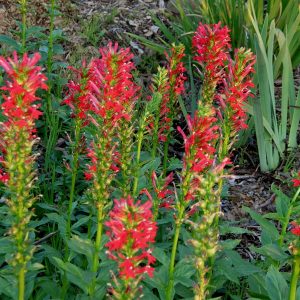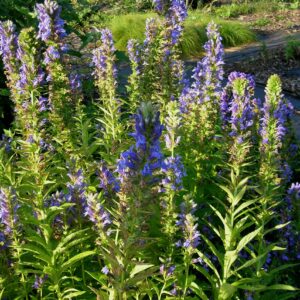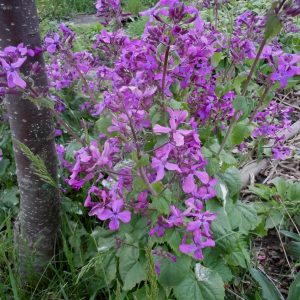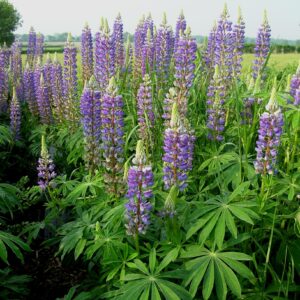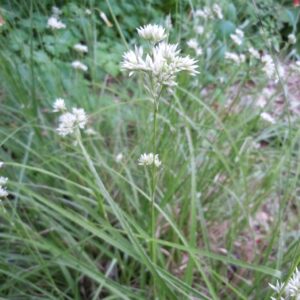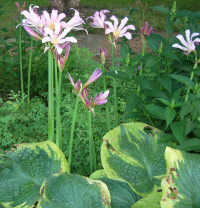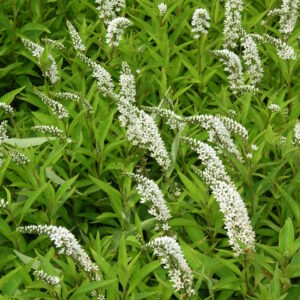Our Plants
Showing 369–376 of 587 results
-
Lobelia cardinalis Cardinal flower Z 3-9
Ruby, cardinal red tubes with an upper lip split in half and a lower lip like a pixie’s apron encircle the spike from August to October beckon hummingbirds to feed.
Ruby, cardinal red tubes with an upper lip split in half and a lower lip like a pixie’s apron encircle the spike from August to October beckon hummingbirds to feed.
Size: 3’ x 12”
Care: sun to part shade in fertile, moist soil. Moist soil important
Native: Canada to Texas, Wisconsin native.
Wildlife Value: attracts hummingbirds
Awards: Received England’s Royal Horticultural Society Award of Merit & Missouri Botanic Garden Plant of Merit.Cherokee cured stomach aches, worms, pain, fever, nose bleeds, rheumatism, headaches, colds, and croup with Lobelia. They used the root to treat syphilis. Other Natives and colonists used the plant to induce vomiting. At the end of a funeral, Meskwaki Indians threw the dried and pulverized plant into the grave. Meskwaki also chopped the roots and secretly put it in the food of “a quarrelsome pair.” Allegedly “this makes the pair love each other again.” Lobelia is named for Matthias L’Obel (1538-1616) French expatriate who immigrated to England and became physician to English King James I. Tradescant the Younger introduced this to European gardens when he sent it to England in 1637. Offered for sale in Bartram Garden’s 1783 Broadside. In 1749 Swedish botanist Peter Kalm wrote that Indians used five species of Lobelia to cure venereal disease, “an infallible art of curing it.” Grown by Washington at Mount Vernon and Thomas Jefferson at Monticello. Pressed specimen in Emily Dickinson’s herbarium.
-
Lobelia siphilitica ‘Alba’ z 4-8
A striking, erect spike of pure white blossoms opening from bottom up. On top club-shaped buds, below trumpet-shapes made of a tube flaring open at the ends with the top of the flare looking like a quarter moon with the circle at the bottom and the lower divided into three, each segment pointed at the ends. Its fresh white blooms stand out in late summer to early fall.
A striking, erect spike of pure white blossoms opening from bottom up. On top club-shaped buds, below trumpet-shapes made of a tube flaring open at the ends with the top of the flare looking like a quarter moon with the circle at the bottom and the lower divided into three, each segment pointed at the ends. Its fresh white blooms stand out in late summer to early fall.
Size: 2-3’ x 1-2’
Care: sun to part shade in moist or moist well-drained soil
Native: The blue form, the species Lobelia siphilitica is native from Connecticut to Wyoming, south to Texas then east to Georgia and all states in between, Wisconsin native.
Wildlife Value: Deer resistant, attracts bees, hummingbirds and some butterflies.This white one is “An albino of occasional occurrence.” Britton, Nathaniel Lord “On the Naming of ‘Forms,’ in the New Jersey Catalogue” Bulletin of the Torrey Botanical Club 17: 121,125. 1890. This may, therefore, be native in the same locations as the blue species or it may not.
-
Lobelia siphilitica Great lobelia Z 4-9
A striking, erect spike of sky to blueberry-blue blossoms. On top club-shaped buds, below trumpet-shapes, open flowers, made of a tube flaring open with the bottom divided into three, each segment pointed at the ends. From late summer to early fall.
A striking, erect spike of sky to blueberry-blue blossoms. On top club-shaped buds, below trumpet-shapes, open flowers, made of a tube flaring open with the bottom divided into three, each segment pointed at the ends. From late summer to early fall.
Size: 3' x 12"
Care: Full sun to part shade in moist to moist well-drained soil
Native: Connecticut to Wyoming, south to Texas then east to Georgia and all states in between, Wisconsin native.
Wildlife Value: attracts bumble bees, hummingbirds and some butterfliesLobelia is named for Matthias L’Obel (1538-1616) a French expatriate who emigrated to England and became physician to English King James I. Cherokee used the root to treat headaches, stomachaches, worms, nosebleeds, colds and syphilis. 1st collected by Rev. John Banister who moved to colonial Virginia in 1678. A gunman mistakenly shot and killed him while he collected plants. In 1749 Swedish botanist Peter Kalm wrote that Indians used five species of Lobelia to cure venereal disease, having “an infallible art of curing it.” According to John Bartram (1699-17760) “The learned Pehr Kalm (who gained the Knowledge of it from Colonel Johnson, who learned it of the Indians, who, after great Rewards bestowed on several of them, revealed the Secret to him) saith, That the Roots of this Plant cureth the Pox much more perfectly and easily than any mercurial Preparations, and is generally used by the Canada Indians, for the Cure of themselves“ (Better than mercury!) Oneidas considered this good medicine for distemper. Sioux treated bloat, diarrhea and dysentery as well as a love charm by adding powdered root to the food of the intended. Offered for sale in Bartram Garden’s 1783 Broadside, America’s 1st plant catalog.
-
Lunaria annua Money plant, Honesty, Silver dollar Biennial Reseeds Z 5-10
Mauve phlox-like blooms spring to early summer turn into silvery, translucent seedpods.
Mauve phlox-like blooms spring to early summer turn into silvery, translucent seedpods.
LIMITED QUANTITIES AVAILABLE, LIMIT OF 1 PER CUSTOMER PLEASE.
Size: 1'-3' x 1’
Care: Full sun to part shade.
Native: mountains of Italy
Wildlife Value: attracts bees and butterfliesOld-fashioned heirloom. Silver dollars are perfect for dried bouquets! Popular in winter flower arrangements since colonial times. Introduced to England from Germany in the late 1500’s and carried to America by the Puritans as a reminder of home. Grown at America’s 1st botanic garden, Elgin Botanic Garden 1811.
**LISTED AS OUT OF STOCK BECAUSE WE DO NOT SHIP THIS ITEM. IT IS AVAILABLE FOR PURCHASE AT OUR RETAIL LOCATION.
-
Lupinus perennis Sun-dial lupin, Old maid’s bonnet, wild pea Z. 4-9
Many flowered blue, pea flowered raceme May-June
Many flowered blue, pea flowered raceme May-June
Size: 1-2' x 12"
Care: full sun in well drained soil. A legume, so it enriches the soil by adding nitrogen.
Native: Maine to FL, Ontario to MN to Louisiana, Wisconsin native.
Wildlife Value: Attracts both hummingbirds and butterflies. The only food for larvae of endangered species, Karner Blue butterfly.Lupinus is Latin from Lupus meaning “wolf.” Likely sent from its native Virginia to England by Tradescant the Younger in 1637. Certainly collected by Frenchman Michaux, who scoured eastern North American over 11 years in late 1700’s. Grown by Jefferson. Grown at America’s 1st botanic garden, Elgin Botanic Garden 1811.The Cherokee used this to stop bleeding. The Menominee fattened their horses with this Lupin and made them spirited. They rubbed the plant on themselves to give power to control the horses.
-
Luzula nivea Snowy woodrush 5-8
Very unusual & ornamental grass. Dense white flower clusters in June-July. Leaves are evergreen with hairy margins. One of few grasses for shady areas.
Very unusual & ornamental grass. Dense white flower clusters in June-July. Leaves are evergreen with hairy margins. One of few grasses for shady areas.
Size: 24” x 24”
Care: part shade to shade in moist well-drained to well-drained soil.
Native: Central and southern Europe, AlpsNamed by Linnaeus in 1753. Genus name Latin meaning “light.” Nivea means “snow white.” According to Liberty Hyde Bailey the flowers are “useful in dried bouquets.”(1933)
-
Lycoris squamigera Surprise lily, Naked lady Z 5-9
Strap-like leaves appear in April, then die back in summer. In August a shoot appears seemingly out-of-no-where, topped with pale pink trumpets. Flowers resemble Amaryllis.
Strap-like leaves appear in April, then die back in summer. In August a shoot appears seemingly out-of-no-where, topped with pale pink trumpets. Flowers resemble Amaryllis
Size: 18-24” x 6”
Care: full sun to part shade in moist well-drained soil
Native: JapanIntroduced to Western gardens from Japan in 1861 by Dr. George Rogers Hall (1820-1899), a physician who moved to Shanghai and became a trader, introducing several Japanese plants to the U.S.
-
Lysimachia clethroides Gooseneck loosestrife Z 3-8
White racemes looking like a goose neck from mid to late summer, deadhead to rebloom
White racemes looking like a goose neck from mid to late summer, deadhead to rebloom
Size: 36" x spreads
Care: sun to part shade in moist well-drained humusy soil
Native: China and Japan
Awards: England’s Royal Horticultural Society Award of MeritDioscorides (1st century A.D.) named Lysimachia after King Lysimachus of Thracia. This species collected before 1844.

